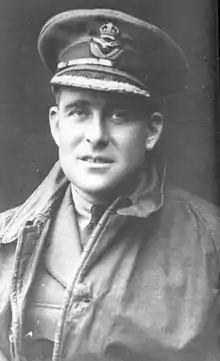Alan Scott (RAF officer)
Group Captain Alan John Lance Scott, CB, MC, AFC (29 June 1883 – 16 January 1922) was an officer in the Royal Flying Corps and Royal Air Force during the First World War and the following years.[1]
Alan John Lance Scott | |
|---|---|
 Scott in Royal Air Force uniform | |
| Nickname(s) | Jack |
| Born | 29 June 1883 Christchurch, New Zealand |
| Died | 16 January 1922 (aged 38) London, England |
| Allegiance | United Kingdom |
| Service/ | British Army Royal Air Force |
| Rank | Group Captain |
| Commands held | Central Flying School (1917–18) No. 60 Squadron RFC (1917) |
| Battles/wars | First World War |
| Awards | Companion of the Order of the Bath Military Cross Air Force Cross |
Early life
Scott was born in Christchurch, New Zealand,[2] on 29 June 1883,[3] but moved to in England where he attended Oxford University, from which he graduated with a law degree. He practiced as a barrister in London, and was acquainted with Lord Birkenhead and Winston Churchill.[2]
First World War
He was originally an officer in the British Army's Sussex Yeomanry, later transferring to the Royal Flying Corps. Scott never became a very good pilot; in fact, in training, he crashed and broke both legs. He continued training on canes, and had to be assisted into the cockpit. However, he was a pugnacious dogfighter whose solo missions sometimes got him into trouble. For instance, on 28 May 1917, he survived being Leutnant Karl Allmenröder's 21st victory.[4]
In July 1917 Scott was awarded the Military Cross:
Capt. (temp Maj.) Alan John Lance Scott Yeo., and R.F.C. For conspicuous gallantry and devotion to duty. He has on several occasions attacked and destroyed enemy aircraft and taken successful photographs under heavy fire. He has constantly shown the greatest courage in attacking numerous hostile machines single-handed, during which on two occasions his own machine was considerably damaged. His great coolness, dash, and resource have set an excellent example to his squadron.[5]
Scott was a flight commander on No. 43 Squadron RFC until 10 March 1917 when he took up command of No. 60 Squadron RFC. He remained as No. 60 Squadron's commander until 11 July 1917, the day after he was wounded in action.[6]
From some time in 1917 to 1918, Scott was the Commandant of the Central Flying School.[7] Notably, Scott acted as Winston Churchill's flying instructor.[8]
Later life
In 1920, Scott's book "Sixty Squadron RAF: A history of the squadron from its formation" was published.[9] Scott died on 16 January 1922 in London, England aged 38.[10]
References
Footnotes
- "William 'Billy Bishop: World War I Canadian Ace Fighter Pilot". HistoryNet. 12 June 2006. Archived from the original on 25 January 2013.
- Claasen 2017, p. 242.
- "Birth search". Births, deaths & marriages online. Department of Internal Affairs. Retrieved 30 January 2016.
- Above the Trenches: A Complete Record of the Fighter Aces and Units of the British Empire Air Forces 1915–1920. p. 333.
- London Gazette Issue 30204 24 July 1917
- Nieuport Aces of World War 1.. p. 30.
- "The Royal Air Force – History Section". Archived from the original on 13 July 2007. Retrieved 23 November 2007.
- "Churchill College". www.chu.cam.ac.uk. Archived from the original on 17 August 2019. Retrieved 17 September 2019.
- Search Results
- "Alan John Lance Scott".
Bibliography
- Claasen, Adam (2017). Fearless: The Extraordinary Untold Story of New Zealand's Great War Airmen. Auckland, New Zealand: Massey University Press. ISBN 978-0-9941407-8-4.
- Nieuport Aces of World War 1. Norman Franks. Osprey Publishing, 2000. ISBN 978-1-85532-961-4.
- Above the Trenches: a Complete Record of the Fighter Aces and Units of the British Empire Air Forces 1915–1920. Christopher F. Shores, Norman L. R. Franks, Russell Guest. Grub Street, 1990. ISBN 978-0-948817-19-9.